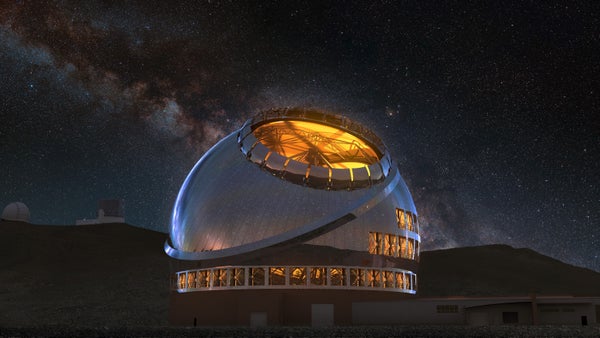
[ad_1]
Two Giant U.S. Telescopes Are Threatened by Federal Funding Cap
The Thirty Meter Telescope and Giant Magellan Telescope might need to compete for survival in the face of federal spending limits

An artist rendering of the Thirty Meter Telescope, planned for construction on Maunakea in Hawaii.
TMT International Observatory/Courtesy of NAOJ with the cooperation of Mitsubishi Electric
US astronomers might have only one huge ground-based telescope in their future, rather than the two that many had hoped for.
Two consortiums of research institutions and other funders have been planning for years to build the Giant Magellan Telescope on a mountaintop in Chile and the Thirty Meter Telescope on the Hawaiian mountain Maunakea. Construction has started in Chile, but only off-site work has been underway for the Thirty Meter Telescope because of concerns from Native Hawaiians about building on Maunakea, which they consider sacred.
Both projects are backed by international groups of funders, but neither has the full amount secured to complete its telescope. The Giant Magellan Telescope is expected to cost US$2.54 billion. Representatives for the Thirty Meter Telescope have not released a final cost estimate, saying it depends on factors such as scheduling, but other experts say it is likely to be at least $3 billion.
On supporting science journalism
If you’re enjoying this article, consider supporting our award-winning journalism by subscribing. By purchasing a subscription you are helping to ensure the future of impactful stories about the discoveries and ideas shaping our world today.
Many astronomers had hoped that the US National Science Foundation (NSF) would contribute money to cover the funding shortfall. But last week the National Science Board, which oversees the NSF, recommended that the agency cap its giant-telescope contributions at $1.6 billion. The board also signalled that it was reluctant for the NSF to spend even that much, citing the need to build other facilities “across a wide range of science and engineering fields”.
Taken together, the board’s actions suggest that the NSF will probably have to choose which of the two telescopes to fund — there might not be enough money for both. The agency is supposed to draw up a plan by May on how to decide which of the two to support.
Both projects could move ahead if they find additional private or other funding. But having the NSF involved would ensure that US astronomers would be allotted a percentage of observing time on the telescopes, rather than it being reserved for scientists who work with other funding partners. The US Congress could also allocate money to the NSF for the telescopes, but researchers see that as unlikely in this time of tight budgets. US lawmakers still haven’t agreed on a budget for the current fiscal year, and policy watchers have predicted that science spending will remain the same or even decrease. On 3 March, a Congressional funding committee said it “strongly encourages” the NSF to consider funding both telescopes — but without any direction as to how much the agency should spend.
Falling behind
Looming over both telescope projects is the fact that the European Southern Observatory’s project is ahead of them: construction is more than halfway complete on the 39-metre-wide Extremely Large Telescope in Chile.
To some US researchers, the idea of losing access to one of the two planned telescopes represents a large blow to the country’s leadership in astronomy. “Great vision should drive great budgets, not vice versa,” says John O’Meara, chief scientist at the W. M. Keck Observatory in Kamuela, Hawaii.
For other scientists, the announcement is a long-needed push, given that it’s been six years since the projects joined forces to ask the NSF for funding. “This is incredibly good news,” says Michael Turner, an astronomer at the University of Chicago in Illinois who penned an editorial in Science in November, arguing that the NSF should fund just one of the projects. “It was going nowhere, and these two projects were withering on the vine.”
After the National Science Board publicly announced the funding cap on 27 February, a spokesperson for the two projects released a joint statement saying that they read the board’s recommendations “with great interest”. They noted that a 2021 survey of US astronomers’ priorities for the next decade ranked building the two giant telescopes at the top of the list for ground-based astronomy. Representatives have been pitching the projects — once bitter rivals — as a partnership of observatories in both the Northern and Southern hemispheres that could together study most of the night sky. Now the observatories might have to compete for survival.
Today’s largest ground-based telescopes, such as the Keck telescopes on Maunakea, have mirrors ranging from 8 to 10 metres wide that gather light from the night sky. Going up in scale would enable big leaps forward in astronomical discoveries, including in exoplanets, supermassive black holes and star formation.
The Giant Magellan Telescope is meant to combine seven mirrors to form a light-gathering surface that is 25 metres wide. The Thirty Meter Telescope is designed to use 492 hexagonal segments to create a mirror that, as its name suggests, is 30 metres across. The plan to build atop Maunakea has been on hold while the state of Hawaii is setting up a new stewardship authority for the mountain, which incorporates more Native Hawaiian representation than in the past.
“These giant telescopes are becoming more expensive than philanthropy can afford,” Turner says. “We need to build an [extremely large telescope], and we need to get going.”
This article is reproduced with permission and was first published on February 29, 2024.
[ad_2]